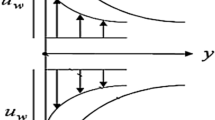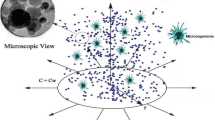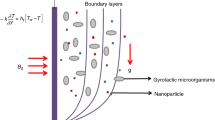Abstract
This article addresses the time-dependent flow of magnetized rheological Carreau nanoliquid conveying microorganisms over a moving wedge with velocity slip and thermal radiation features. Carreau fluid is auspicious to depict several types of physical issues because this fluid model has the capability of revealing the rheology of multiple specific fluids such as fluids with brief-chain suspension particles, fluid crystals, detergents, and blood in animals and humans. The mathematical formulation is developed by combining the impact of infinite shear rate viscosity. The physical aspects for both static and moving are discussed in detail. At first, relevant similarity transformations are employed to obtain dimensionless form of equations, and then renovated equations have been solved numerically by employing bvp4c via MATLAB based on shooting technique. Both the numerical and graphical results against physical quantities, such as velocity temperature, nanoparticles concentration and density of gyrotactic microorganism, are observed under the influence of physical parameters.





















Similar content being viewed by others
References
Buongiorno J, Hu LW, Kim SJ, Hannink R, Truong B, Forrest E. Nanofluids for enhanced economics and safety of nuclear reactors: an evaluation of the potential features. Issues Res Gaps Nuclear Technol. 2008;162:80–91.
Choi SU, Eastman JA. Enhancing thermal conductivity of fluids with nanoparticles. Argonne Natl Lab IL (United States). 1995;1:1–8.
Nadeem S, Akram S. Influence of inclined magnetic field on peristaltic flow of a Williamson fluid model in an inclined symmetric or asymmetric channel. Math Comput Model. 2010;152:107–19.
Vasudev C, Rao UR, Reddy MS, Rao GP. Peristaltic pumping of Williamson fluid through a porous medium in a horizontal channel with heat transfer. Am J Sci Ind Res. 2010;13:656–66.
Gorla RS, Gireesha BJ. Dual solutions for stagnation-point flow and convective heat transfer of a Williamson nanofluid past a stretching/shrinking sheet. Heat Mass Transf. 2016;152:1153–62.
Li H, Liu S, Dai Z, Bao J, Yang X. Applications of nanomaterials in electrochemical enzyme biosensors. Sensors. 2009;9:8547–61.
Kuznetsov AV, Nield DA. Natural convective boundary-layer flow of a nanofluid past a vertical plate. Int J Therm Sci. 2010;149:243–7.
Rashidi S, Javadi P, Esfahani JA. Second law of thermodynamics analysis for nanofluid turbulent flow inside a solar heater with the ribbed absorber plate. J Therm Anal Calorim. 2019;135:551–63.
Maleki H, Safaei MR, Togun H, Dahari M. Heat transfer and fluid flow of pseudo-plastic nanofluid over a moving permeable plate with viscous dissipation and heat absorption/generation. J Therm Anal Calorim. 2019;135:1643–54.
Khan A, Ali HM, Nazir R, Ali R, Munir A, Ahmad B, Ahmad Z. Experimental investigation of enhanced heat transfer of a car radiator using ZnO nanoparticles in H2O–ethylene glycol mixture. J Therm Anal Calorim. 2019;138:3007–211.
Szilagyi IM, Santala E, Heikkilä M, Kemell M, Nikitin T, Khryashchev L, Rasanen M, Ritala M, Leskelä M. Thermal study on electrospun polyvinylpyrrolidone/ammonium metatungstate nanofibers: optimising the annealing conditions for obtaining WO3 nanofibers. J Therm Anal Calorim. 2011;105:73–81.
Nasiri H, Jamalabadi MYA, Sadeghi R, Safaei MR, Nguyen TK, Shadloo MS. A smoothed particle hydrodynamics approach for numerical simulation of nanofluid flows. J Therm Anal Calorim. 2019;135:1733–41.
Nazari S, Ellahi R, Sarafraz MM, Safaei MR, Asgari A, Akbari OA. Numerical study on mixed convection of a non-Newtonian nanofluid in a square cavity with porous media and two lid-driven. J Therm Anal Calorim. 2019. https://doi.org/10.1007/s10973-019-08841-1.
Hassan A, Wahab A, Qasim MA, Janjua MM, Ali MA, Ali HM, Jadoon TR, Ali E, Raza A, Javaid N. Thermal management and uniform temperature regulation of photovoltaic modules using hybrid phase change materials-nanofluids system. Renew Energy. 2020;145:282–93.
Ambreen T, Saleem A, Ali HM, Shehzad SA, Park CW. Performance analysis of hybrid nanofluid in a heat sink equipped with sharp and streamlined micro pin-fins. Powder Technol. 2019;355:552–63.
Sarafraz MM, Pourmehran O, Yang B, Arjomandi M, Ellahi R. Pool boiling heat transfer characteristics of iron oxide nano-suspension under constant magnetic field. Int J Therm Sci. 2020;142:106131.
Marin M, Nicaise S. Existence and stability results for thermoelastic dipolar bodies with double porosity. Contin Mech Thermodyn. 2016;28:1645–57.
Marin M, Ellahi R, Chirilă A. On solutions of Saint-Venant's problem for elastic dipolar bodies with voids. Carpathian J Math. 2017;33:219–32.
Marin M, Vlase S, Ellahi R, Bhatti MM. On the partition of energies for the backward in time problem of thermoelastic materials with a dipolar structure. Symmetry. 2019;863:1–16.
Sheikholeslami M. New computational approach for exergy and entropy analysis of nanofluid under the impact of Lorentz force through a porous media. Comput Methods Appl Mech Eng. 2019;344:319–33.
Sheikholeslami M, Rezaeianjouybari M, Darzi M, Shafee A, Zhixiong L, Truong KN. Application of nano-refrigerant for boiling heat transfer enhancement employing an experimental study. Int J Heat Mass Transf. 2019;141:974–80.
Alamri SZ, Ellahi R, Shehzad N, Zeeshan A. Convective radiative plane Poiseuille flow of nanofluid through porous medium with slip: an application of Stefan blowing. J Mol Liq. 2019;273:292–304.
Majeed A, Zeeshan A, Bhatti MM, Ellahi R. Heat transfer in magnetite (Fe3O4) nanoparticles suspended with conventional fluids: refrigerant-134a (C2H2F4) kerosene (C10H22) and water (H2O) under the impact of dipole. Heat Transf Res. 2020;51:217–32.
Khan LA, Reza M, Mir NA, Ellahi R. Effects of different shapes of nanoparticles on peristaltic flow of MHD nanofluids filled in an asymmetric channel. J Therm Anal Calorim. 2019. https://doi.org/10.1007/s10973-019-08348-9.
Ellahi R. The effects of MHD and temperature dependent viscosity on the flow of non-Newtonian nanofluid in a pipe: analytical solutions. Appl Math Model. 2013;37(3):1451–7.
Hill NA, Pedley TJ, Kessler JO. Growth of bioconvection patterns in a suspension of gyrotactic micro-organisms in a layer of finite depth. J Fluid Mech. 1989;208:509–43.
Pedley TJ, Kessler JO. Hydrodynamic phenomena in suspensions of swimming microorganisms. Annu Rev Fluid Mech. 1992;24:313–58.
Kuznetsov AV. The onset of nanofluid bioconvection in a suspension containing both nanoparticles and gyrotactic microorganisms. Int Commun Heat Mass Transf. 2010;37:1421–5.
Siddiqa S, Begum N, Saleem S, Hossain MA, Gorla RS. Numerical solutions of nanofluid bioconvection due to gyrotactic microorganisms along a vertical wavy cone. Int J Heat Mass Transf. 2016;101:608–13.
Zhao B, Su Y, Zhang Y, Cui G. Carbon dioxide fixation and biomass production from combustion flue gas using energy microalgae. Energy. 2015;89:347–57.
Alsaedi A, Khan MI, Farooq M, Gull N, Hayat T. Magnetohydrodynamic (MHD) stratified bioconvective flow of nanofluid due to gyrotactic microorganisms. Adv Powder Technol. 2017;28:288–98.
Khan WA, Uddin MJ, Ismail AM. Free convection of non-Newtonian nanofluids in porous media with gyrotactic microorganisms. Trans Porous Med. 2013;97:241–52.
Xun S, Zhao J, Zheng L, Zhang X. Bioconvection in rotating system immersed in nanofluid with temperature dependent viscosity and thermal conductivity. Int J Heat Mass Transf. 2017;111:1001–6.
Zuhra S, Khan NS, Islam S. Magnetohydrodynamic second-grade nanofluid flow containing nanoparticles and gyrotactic microorganisms. Comput Appl Math. 2018;37:6332–588.
Waqas H, Khan SU, Imran M, Bhatti MM. Thermally developed Falkner-Skan bioconvection flow of a magnetized nanofluid in the presence of a motile gyrotactic microorganism: Buongiorno’s nanofluid model. Phys Scr. 2019;94:115304.
Waqas H, Khan SU, Hassan M, Bhatti MM, Imran M. Analysis on the bioconvection flow of modified second-grade nanofluid containing gyrotactic microorganisms and nanoparticles. J Mol Liq. 2019;291:111231.
Carreau PJ. Rheological equations from molecular network theories. Trans Soc Rheol. 1972;116:99–127.
Khan M, Azam M. Unsteady boundary layer flow of Carreau fluid over a permeable stretching surface. Results Phys. 2016;6:1168–74.
Khan M, Azam M, Alshomrani AS. Unsteady slip flow of Carreau nanofluid over a wedge with nonlinear radiation and new mass flux condition. Results Phys. 2017;7:2261–70.
Alwatban AM, Khan SU, Waqas H, Tlili I. Interaction of Wu’s slip features in bioconvection of Eyring Powell nanoparticles with activation energy. Processes. 2019;7:859.
Ellahi R, Hussain F, Abbas SA, Sarafraz MM, Goodarzi M, Shadloo MS. Study of two-phase Newtonian nanofluid flow hybrid with Hafnium particles under the effects of slip. Inventions. 2020;5:6.
Ellahi R, Alamri SZ, Basit A, Majeed A. Effects of MHD and slip on heat transfer boundary layer flow over a moving plate based on specific entropy generation. J Taibah Univ Sci. 2018;12(4):476–82.
Ellahi R, Zeeshan A, Hussain F, Abbas T. Thermally charged MHD bi-phase flow coatings with non-Newtonian nanofluid and Hafnium particles through slippery walls. Coatings. 2019;9:300.
Abdelmalek Z, Khan SU, Waqas H, Riaz A, Khan IA, Tlili I. A mathematical model for bioconvection flow of Williamson nanofluid over a stretching cylinder featuring variable thermal conductivity, activation energy and second-order slip. J Therm Anal Calorim. 2020;22:1–3.
Keskin AU. Solution of BVPs using bvp4c and bvp5c of MATLAB. Boundary value problems for engineers. Cham: Springer; 2019. p. 417–510.
Hale N, Moore DR. A sixth-order extension to the MATLAB package bvp4c of J. Kierzenka and L. Shampine. 2008.
White FM. Viscous fluid flow. New York: McGraw-Hill; 1991.
Acknowledgements
The first author T. Muhammad extends his appreciation to the Deanship of Scientific Research at King Khalid University for providing him funding through Research Groups Program under Grant Number (R.G.P.2/66/40).
Author information
Authors and Affiliations
Corresponding author
Additional information
Publisher's Note
Springer Nature remains neutral with regard to jurisdictional claims in published maps and institutional affiliations.
Rights and permissions
About this article
Cite this article
Muhammad, T., Alamri, S.Z., Waqas, H. et al. Bioconvection flow of magnetized Carreau nanofluid under the influence of slip over a wedge with motile microorganisms. J Therm Anal Calorim 143, 945–957 (2021). https://doi.org/10.1007/s10973-020-09580-4
Received:
Accepted:
Published:
Issue Date:
DOI: https://doi.org/10.1007/s10973-020-09580-4




